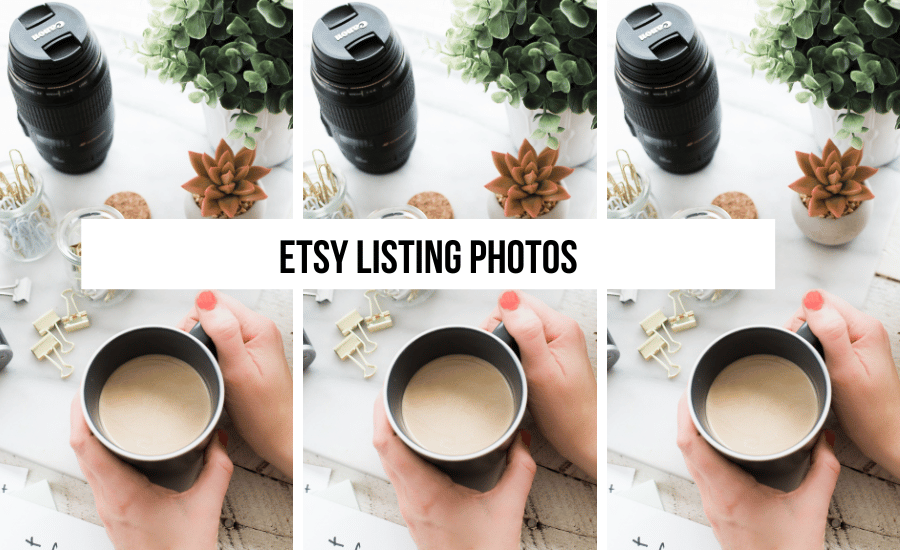If you’re an Etsy seller, you know how important listing photos are for attracting potential buyers. In fact, they can make or break a sale. However, taking great listing photos isn’t just about having a good camera or being a professional photographer. There are specific dos and don’ts that you need to keep in mind to ensure that your photos are eye-catching, engaging, and accurately represent your products.
Unfortunately, many Etsy sellers make common mistakes when it comes to their listing photos, which can negatively impact their sales. That’s why in this article, we’ll explore the dos and don’ts of Etsy listing photos and share some common mistakes to avoid.
Whether you’re a new Etsy seller or experienced, following these tips can help you improve your listing photos and increase your sales. So, let’s dive in!

Home > Etsy Biz > Etsy Listing Photos
DISCLOSURE: This is a sponsored post. Through my links, I may receive a commission if you decide to make purchases at no cost for yourself! Check out our disclaimer for more info on how it works.
The Importance of Etsy Listing Photos
As an Etsy seller, you know that your listing photos are the first things that potential buyers will see when they come across your shop. Your photos need to be engaging, eye-catching, and accurately represent your products. In fact, according to Etsy, listings with high-quality photos are 2.5 times more likely to sell than those with low-quality photos. That’s why it’s crucial to spend time and effort creating the best possible listing photos.
Your listing photos are not just about showing what your products look like. They need to tell a story, evoke emotions, and showcase the unique qualities of your products. Your photos should also showcase your brand’s personality and style. For example, if your brand is all about sustainability and eco-friendliness, your photos should reflect that by using natural backgrounds and props.
Common Mistakes in Etsy Listing Photos
Many Etsy sellers make common mistakes when taking their listing photos, which can negatively impact their sales. Here are some of the most common mistakes to avoid:
Using Low-Quality Photos
One of the biggest mistakes you can make is using low-quality photos. Your photos should be clear, sharp, and high-resolution. Low-quality photos can make your products look unprofessional and unappealing.
Using Busy Backgrounds
Another common mistake is using busy backgrounds that distract from your products. Your backgrounds should be simple and neutral, so your products can be the focal point. Avoid using busy patterns or cluttered backgrounds that make it hard to see your products clearly.
Not Using Enough Photos
You should include multiple photos of each product from different angles and perspectives. This will give potential buyers a better idea of what your products look like and help them make an informed decision. If you only include one or two photos, potential buyers may not feel confident in their purchase.
Not Using Descriptive Titles and Captions
Your listing titles and captions are just as important as your photos. They should be descriptive, informative, and accurately represent your products. Use descriptive words to highlight the unique features and benefits of your products.
Not Showcasing the Size and Scale of Your Products
It’s essential to showcase the size and scale of your products in your photos. This can be done by including a reference object, such as a coin or ruler, or by including photos of your products in use. This will help potential buyers understand the size and scale of your products and avoid any surprises when they receive their orders.

Dos for Etsy Listing Photos
Now that we’ve covered some common mistakes to avoid, let’s look at some dos for creating great Etsy listing photos:
Use Natural Lighting
Natural lighting is best for taking great photos. Position your products near a window or a well-lit area to get the best results. Avoid using flash, as it can create harsh shadows and alter the colors of your products.
Use a Simple Background
As we mentioned earlier, your background should be simple and neutral. A white or light-colored background is ideal, as it will make your products stand out. You can also use a textured background, such as wood or fabric, to add some visual interest.
Use Props and Styling
Props and styling can add some personality and style to your photos. Use props that complement your products and reflect your brand’s personality. For example, if you sell handmade ceramics, you could use natural materials like wood or linen as props.
Use Multiple Angles and Perspectives
As we mentioned earlier, using multiple angles and perspectives can give potential buyers a better idea of what your products look like. Take photos from different angles, such as overhead shots or close-ups, to showcase the unique features of your products.
Use Photo Editing Tools
Photo editing tools can help enhance your photos and make them look more professional. You can use tools like Photoshop or Lightroom to adjust the brightness, contrast, and color of your photos. However, be careful not to over-edit your photos, as this can make them look fake and unappealing.
Don’ts for Etsy Listing Photos
Here are some don’ts to keep in mind when taking your Etsy listing photos:
Don’t Use Filters
Filters can make your photos look unprofessional and alter the colors of your products. Stick to natural lighting and avoid using filters.
Don’t Use Stock Photos
Using stock photos can be misleading and make potential buyers feel like they’re being scammed. Always use your own photos to accurately represent your products.
Don’t Use Inconsistent Lighting
Inconsistent lighting can make your photos look unprofessional and alter the colors of your products. Make sure to use consistent lighting throughout your photos.
Don’t Over-Edit Your Photos
As we mentioned earlier, over-editing your photos can make them look fake and unappealing. Use editing tools to enhance your photos, but be careful not to overdo it.
Don’t Use Busy Backgrounds
As we mentioned earlier, using busy backgrounds can distract from your products. Stick to simple, neutral backgrounds to make your products stand out.
How to Take Great Etsy Listing Photos
Now that you know the dos and don’ts of Etsy listing photos, let’s look at some tips for taking great photos:
Invest in a Good Camera
Investing in a good camera can make a huge difference in the quality of your photos. However, if you can’t afford a professional camera, don’t worry. You can still take great photos with your smartphone.
Use a Tripod
Using a tripod can help stabilize your camera and prevent shaky photos. This is especially important if you’re taking close-up or detailed shots of your products.
Experiment with Different Angles and Perspectives
Experimenting with different angles and perspectives can help you find the best way to showcase your products. Try taking photos from different heights, angles, and distances to see what looks best.
Take Photos in Natural Light
As we mentioned earlier, natural lighting is best for taking great photos. Try to take your photos during the day when there’s plenty of natural light.
Use a Remote Shutter Release
Using a remote shutter release can help prevent camera shake and ensure that your photos are sharp and clear.
Editing Etsy Listing Photos
After you’ve taken your photos, it’s time to edit them. Here are some tips for editing your Etsy listing photos:
Adjust the Brightness and Contrast
Adjusting the brightness and contrast can help bring out the details in your photos. Be careful not to overdo it, as this can make your photos look fake and unappealing.
Crop and Straighten Your Photos
Cropping and straightening your photos can help improve their composition and make them look more professional.
Adjust the Color Balance
Adjusting the color balance can help correct any color issues in your photos. Be careful not to oversaturate your photos, as this can make them look fake and unappealing.
Use the Clone Stamp Tool
The clone stamp tool can help remove any distractions or imperfections in your photos. Use it to remove any dust, scratches, or unwanted objects.
Lighting for Etsy Listing Photos
Lighting is crucial for taking great Etsy listing photos. Here are some tips for lighting your photos:
Use Natural Light
As we mentioned earlier, natural light is best for taking great photos. Position your products near a window or a well-lit area to get the best results.
Use a Reflector
A reflector can help bounce light onto your products and reduce harsh shadows. You can use a white foam board or a professional reflector for this.
Use a Lightbox
A lightbox can help diffuse light and eliminate harsh shadows. You can buy a professional lightbox or make one yourself using a cardboard box and white tissue paper.
Backgrounds for Etsy Listing Photos
As we mentioned earlier, your background should be simple and neutral. Here are some tips for choosing the right background for your photos:
Use a White or Light-Colored Background
A white or light-colored background is ideal, as it will make your products stand out. You can also use a textured background, such as wood or fabric, to add some visual interest.
Use a Consistent Background
Using a consistent background throughout your photos can help create a cohesive look for your shop. Make sure to use the same background for all your products.
Use a Background That Complements Your Products
Your background should complement your products and reflect your brand’s personality. For example, if you sell handmade ceramics, you could use natural materials like wood or linen as a background.
Conclusion
In conclusion, taking great Etsy listing photos is essential for attracting potential buyers and increasing your sales. By following the dos and don’ts we’ve discussed in this article, you can improve your listing photos and create a cohesive and professional look for your shop.
Remember to use natural lighting, simple backgrounds, and multiple angles and perspectives to showcase your products in the best possible way. With some practice and experimentation, you can create listing photos that accurately represent your products, tell a story, and showcase your brand’s personality and style.

+ show Comments
- Hide Comments
add a comment